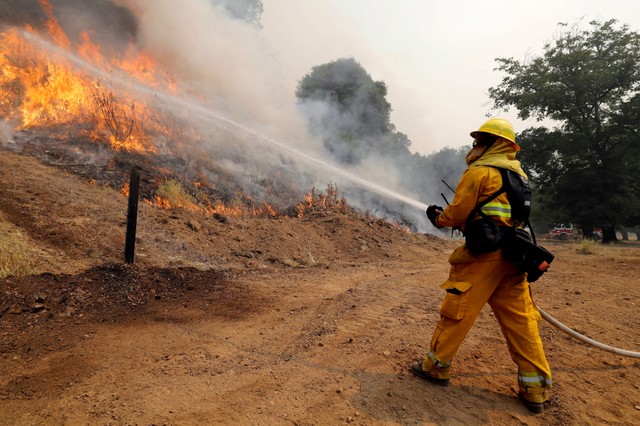LOS ANGELES (Reuters) – California fire captain Robert Veverka and his crew arrived in Redding, California, last Thursday night as gale-force winds whipped the Carr Fire into a flaming tornado. They spent the next 30 hours trying to save homes from the flames.
Veverka and his team from the California Department of Forestry and Fire Prevention (Cal Fire) had just come from another wildfire, using part of their 24-hour break between shifts to travel to Redding.
That is becoming the new normal for firefighters, said Veverka,
“Right now, it’s pretty much guaranteed we’ll go from fire to fire to fire, until everything is out,” the 34-year-old Veverka said in a phone interview. “Once you hit the three- or four-week mark, you’re just constantly exhausted.”
The Carr Fire in Northern California, the largest and most destructive of 16 major blazes in the state, is exhausting firefighting resources in what authorities are calling one of the worst and earliest fire seasons in years.
Severe, year-round fires have been trending the past decade across the U.S. West, according to the National Interagency Fire Center. California in particular has experienced its worst start to the fire season in a decade, in terms of acreage burned, according to the National Interagency Fire Center.
Driving the wildfires are exceptional drought conditions in large areas of Utah, Arizona, New Mexico and Colorado, along with abnormally high temperatures. Nearly all of California faces abnormally dry or drought conditions, according to the Drought Monitor agency.
“We are concerned about firefighter fatigue and making sure that our firefighters remain focused and try to get a break when they can,” said Cal Fire Assistant Deputy Director Daniel Berlant.
“The peak of fire season is ahead of us and we still have many more months to go in this calendar year,” Berlant said.
PRISON FIREFIGHTERS
Veverka overseas one of Cal Fire’s team of prison inmates who are placed on the fire line, in exchange for about $25 a day and a reduction of their sentences.
In the “off-season,” he exercises every day to prepare for the demanding summer firefights. Some prison inmates are not as fit, and about five times a summer, a helicopter has to airlift prisoners suffering from heat exhaustion, he said.
Crews typically work a 24-hour shift followed by a 24-hour rest period typically in a motel, Cal Fire officials said.
After crews spend 14 days on alternating work and rest periods, authorities try to give them a two-day break, Berlant said. But sometimes crews must wait three weeks for their two-day break, he said.
Veverka, from Alturas, California, and his crew have at times gone 40 or 50 days before receiving a two-day break, he said. Berlant acknowledged Cal Fire crews sometimes received such long assignments, but said it was rare.
The Carr Fire, which has killed four civilians and two firefighters, has been particularly demanding for firefighters. The long shift Veverka and his crew worked when they arrived was typical of what other crews worked that day, according to the local fire chief.
Shasta County Fire Chief Mike Hebrard told a news conference on Sunday that some were working 48 hours straight. “They were just going on pure adrenaline.”
DECEMBER FIRE
Veverka was activated to wildfire duty on July 1. In a typical year, his deployment winds down by the end of October.
But California fire officials have repeatedly warned the fire season is getting longer and more intense. The Thomas Fire erupted in December in Ventura and Santa Barbara counties and became the largest in state history.
Higher temperatures have helped extend the period of wildfires by 60 to 80 days each year, National Interagency Fire Center spokeswoman Jennifer Jones said.
The U.S. Forest Service has a different work shift structure from Cal Fire. Forest Service crews typically work 16-hour shifts, followed by eight hours of rest, with two days of rest after 14 days on assignment, officials said.
Research has shown that, over time, it can take a long-term toll on the bodies of the men and women protecting homes, businesses and natural landmarks.
“Over time, the body is not able to respond as well, and one of the things we typically see is firefighters get sick,” Joseph Domitrovich, exercise physiologist with the Forest Service, said in a phone interview.
“It’s where their immune system, with repeated activity or fire work stress, they tend to get what we call ‘camp crud,’ which is an upper respiratory tract infection.”
Physical exhaustion has also been blamed for a number of safety mishaps that have killed firefighters.
For instance, four firefighters died in 2001 when they were caught in the Thirtymile Fire in Washington state. The U.S. Forest Service, in a report, said fatigue was a factor in the poor decision-making that led up to the deaths.
The night before their deaths, the firefighters had only slept for one to three hours while traveling to the fire, the report said.




